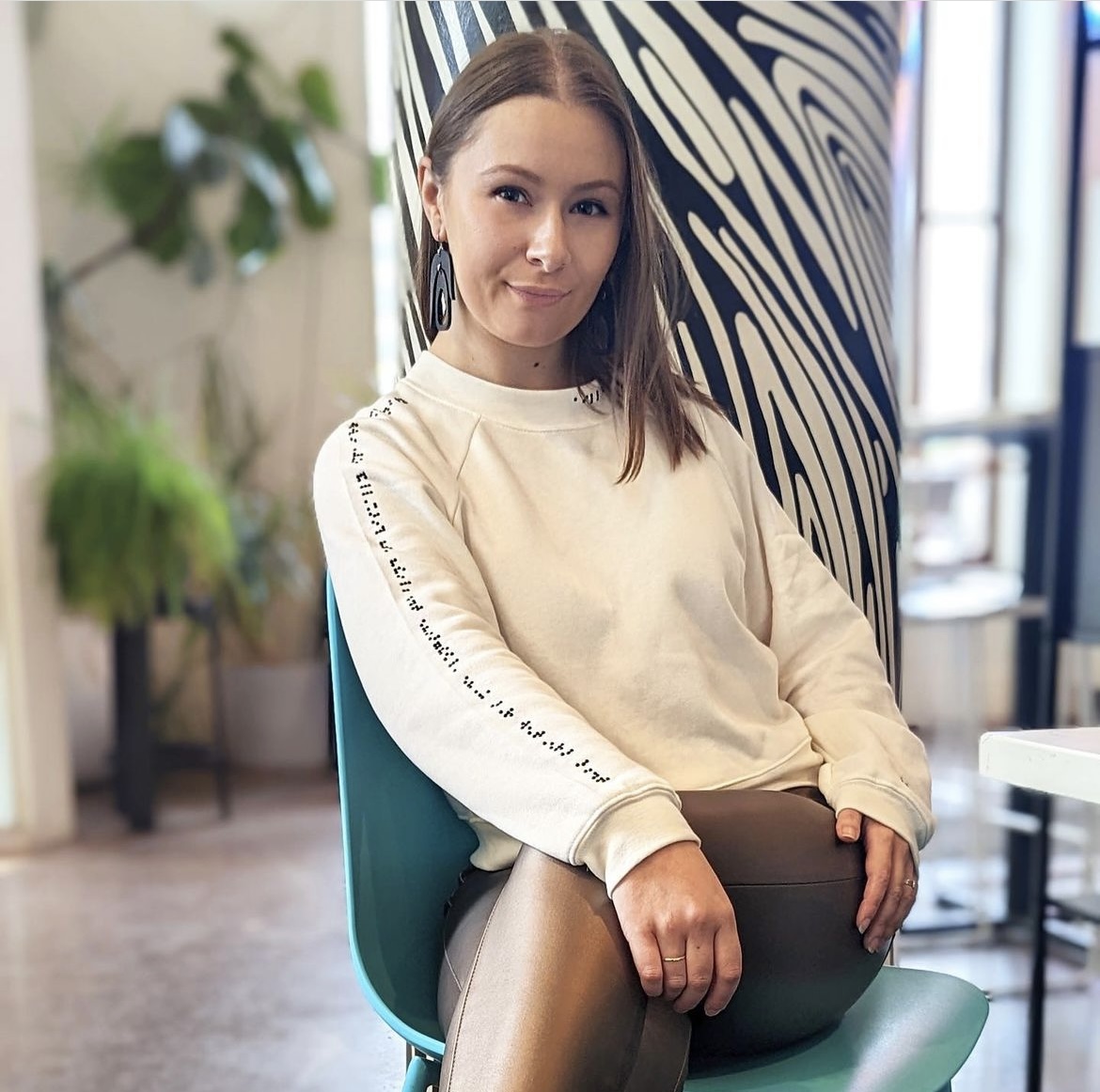The 50 States Project is a series of candid conversations with interior designers across the country about how they’ve built their businesses. This week, Burlington, Connecticut–based designer Kristen McCory tells us how her background as a pro athlete has informed her design career, how she reframed the process of delegating and why a house’s character matters more than square footage.
When you look back, what are your earliest memories of being drawn to design?
When I was a teenager and my friends were requesting Teen Beat magazine, I’d ask my mom for Architectural Digest—I was prowling through those magazines in middle school. In high school, I was playing basketball and being recruited by colleges, and as I realized that it could turn into a scholarship situation, I very much narrowed down my schools to those that had interior design programs. I ended up going to Syracuse University—the basketball was great and I really loved the coaches, but their interior design and textiles programs were the final decision maker.
I started in the interior design program, but I ended up changing my major. [The basketball team] traveled so much, and I was missing a ton of classes that first season. You have a lot of perks as a Division 1 athlete—[the school] makes sure that you are going to succeed in your studies, so we had a mandatory study table and tutors—but as a design major, I couldn’t bring the majority of my art or renderings to those study tables. This was almost 30 years ago, so it wasn’t all on the computer—it was paints and drawings. I was trying to play catch-up, but my professors said, “The days in the classes that you’re missing due to travel can’t necessarily be made up,” and I had to make a decision. It was ironic because I went to Syracuse on a full scholarship to play basketball, but I chose it because of the design [curriculum] and now I was forced to choose: Give up basketball and lose your scholarship or give up design. I changed majors and went into surface pattern design. We were designing anything with a surface pattern—wallpaper, fabrics, china—but I still took interior design courses here and there as electives.
Basketball shaped your early post-graduation plans, too.
It was the beginning of women’s basketball—there were new professional leagues called the ABL, which ended up folding, and then the WNBA—and they were still trying to figure it out. I was trying out for a lot of those teams, and I ended up not making it, so I decided to go play in Europe. I got picked up by a team in Luxembourg; the following year, I went to Finland and played there for about three years.
The way that the European Cup happens, there’s one team in every country that is considered the country’s team—the Euro team—and I was on that team, so instead of playing other teams within the country, we traveled all over Europe playing against the other countries. I ended up visiting countries like Denmark, Ukraine, Latvia, Lithuania—places I might otherwise never go to, which was fantastic.
Was there a sense in the back of your mind that you would come back and have a career in the design field?
Always, 100 percent. While I was over there, I did my best to go to every museum I could. I traveled any chance I got when we were off. I was the one that jumped on the train and took off to France for the weekend. I blew my knee out and needed surgery halfway through my last season in Finland, so I ended up coming home a little early. At that point, I felt like I’d been out of the loop for a little too long, and I decided to hang up the shoes and pursue my career in design.
How did you dive in?
I didn’t know where to begin. I felt like I’d lost momentum. So I said, “Let me go get a job in New York at the D&D Building and learn the back end so that I can really understand fabrics and wallcoverings and how things are made.” I took a showroom job with Stark and Old World Weavers. It wasn’t just sitting behind the desk selling—we also dealt with a lot of the artists that were designing wallpaper, or coming up with colorways, or going to the mills to see how things were done. Carl and Iris Apfel were still there [with Old World Weavers,] and I look back and laugh because I had no clue. Every Wednesday, Carl would take me around the showroom and spend two hours educating me on fabrics—how they were made and what they did. Iris would pop in every so often. I look back at that and can’t believe I had that experience, but at the time, I really didn’t know what I was experiencing.
That’s an amazing training ground.
When I left the city to come back home to Connecticut, I went looking for another job with designers. I had been inspired by some of the wallpaper companies that we dealt with at Stark, and I got involved in decorative painting. It wasn’t like, “Oh, we’re gonna rag a wall.” It was a lot of detailed work—floors, gilding—and I started my business doing that. I was working alongside designers, so I got to be in higher-end homes doing things that were a little bit outside the box. From there, it just evolved. In 2008, I felt confident enough, and I started my business.
How did you build your business at the beginning?
A couple of my first clients happened to be basketball players—they had all played at UConn, and I think being ex-athletes, there was that initial connection. It started out as, “Hey, we’re building a house. We hear you do great decorative painting, but we also want to use you for some design work.” And it took off from there.
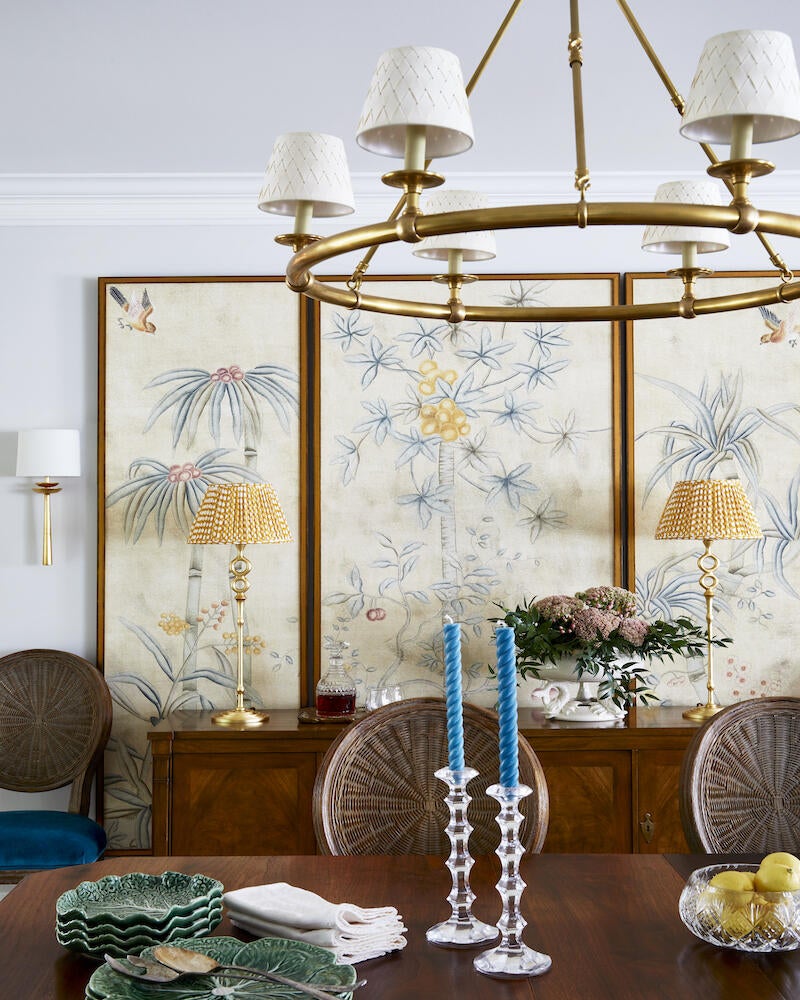
Framed wallpaper panels anchor a dining roomRead McKendree
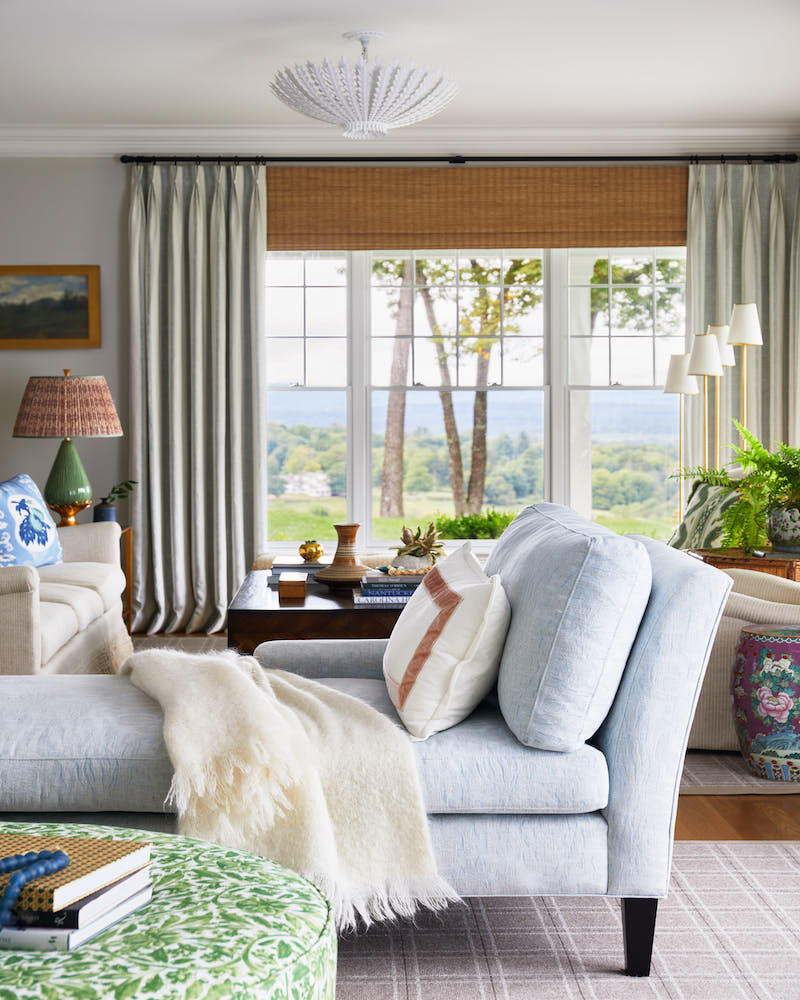
A collected sitting room mixes plush upholstery with antique finds and a lush viewRead McKendree
Left: Framed wallpaper panels anchor a dining room Read McKendree | Right: A collected sitting room mixes plush upholstery with antique finds and a lush view Read McKendree
What does your business look like today?
We strive for the full house. We probably do one full, larger home every two years, and then in between we have projects with less construction—maybe they’re hiring us to come in and do the whole first floor, or we’ll do the whole house, but not all at once because they’re living there. We go in full service and we design from scratch, present and then execute. I have three team members right now, as well as people on the outside who are consistent players in my business, and we just opened a new office, which has been great. The pandemic really lit a flame under me—it was, “OK, we can either change careers, or we can completely dive in, take a chance and go big or go home.” For me, this is big.
What made you realize it was time to take the chance and grow?
I had one person working remotely who took care of all my billing and bookkeeping. The pandemic had just hit when she called and said she was retiring. I was nervous to make a full-time hire, but decided to take the chance. I put an ad out there, and got multiple resumes that day. But there was one in particular that made me think, “She’s the one.” It wasn’t even a question.
How did you know?
Everything on her resume was my dream list. I interviewed her that day, then called my bookkeeper and said, “I need you to interview her, because you know what goes on in the back end.” When she hung up with the candidate, she was like, “She’s it.”
Did you interview anybody else?
I actually did not.
What had you wanted that role to be, and how has it evolved?
The role is business operations. I needed her to learn Design Manager, and to really dig in and understand the industry—and even though my [original] bookkeeper was retiring, she offered to take three to four months to train [the new hire] so that the transition would be easy. She pretty much does everything now. I think one of the things that’s most helpful is that she [vets] new clients to make sure we are working for the correct people. She takes time to really interview them, to understand what they’re looking for, and make sure that they fit our profile, understand our process and are willing to work the way we prefer to work.
Did you feel the difference once she took that on?
Instantly. I love people—I want to get to know them and I give everyone the benefit of the doubt. I think everyone has great intentions, and I want everyone to have good design, even clients that were not a fit. She was able to say, “We’re going to tighten this up.” Now, she explains the process so they know what they’re signing up for, and gets in their heads so that we know what we’re signing up for.
How does that impact the onboarding process?
Nothing happens overnight. We just signed three new clients that we’ve been in communication with [for a long time]—one of them since December 2021. They interviewed us, we met with them, we had a plan for how the process would go, and they were kind of on board but weren’t sure, so they stepped away and tried to do things themselves. They called us again, asked a lot of questions, and that conversation has been going again since summer. They finally came back to us in November to say “I think we’re ready to move forward with you. We understand how you work and we approve the process, so let’s meet and talk again.” And they just signed the agreement. The other clients—one sent her submission form back in May and it’s been back and forth since then.
What holds them back initially?
I think the reality is they know they’re going to be spending money, but they need to come to terms with how we work, and a realistic budget that makes sense for what they’re asking for, and with saying, “OK, I’m going to hand over the reins. I’m not going to shop, I’m going to let them do their job, and I’m going to go through the process and communicate to the best of my ability.” By the time they sign, they understand what they’re getting and they’re comfortable with it. With everyone we’ve been dealing with, it’s been a joy because we’re all on the same page.
Does that ever feel risky? It must mean that you’re investing time and energy having these conversations with some people who don’t eventually sign—who just can’t get there.
Honestly, it’s a blessing. When we first changed our process [to be more discriminating about clients], there was a fear that I was never going to have any more work. But after the last year and a half to two years, we are in such a great rhythm and I don’t have that fear anymore. If someone isn’t ready to commit, they’re not ready to commit.
At no point do I ever feel like we’re putting pressure on someone, because it’s got to feel right for both of us. If it doesn’t, it’s not going to be good. Look, there’s going to be friction somewhere. But I used to take on jobs thinking, “It’s going to be a great job, but—” There was always a “but” and I’d still take the job. We’ve gotten past that point now.
When did you add your other two team members, and what are their roles?
My second team member joined in 2021, and she handles procurement, vendor relations and customer service. The pandemic made it clear that I needed a dedicated person to manage the struggle of ordering, receiving broken items and damaged goods, because what used to take maybe half a day and a couple of emails to solve a situation has turned into a full-time gig. My third employee joined in 2022 as a right-hand person to help me with whatever I’m working on, whether it’s researching design or scheduling and being in touch with clients when things are arriving or contractors are showing up.
Do you think the challenges of order management have become business as usual in the industry at this point?
I don’t see it shifting. Lately we’ve had more troubleshooting as far as damaged goods than before the pandemic, and all the designers I’ve talked to are seeing the same thing. And as we grow, we have much larger clients and a lot more transactions, so there’s just more of it.
As you’ve grown your team, what are the things that you’ve wanted to hold on to for yourself?
Designing. That’s all I want to do.
I want to go back to client onboarding for a moment. At no point did you mention you interviewing the clients during the interview process. Does that mean that you are signing projects and you’ve never met the client?
Yes. Well, no, that’s not exactly true. Once we get to the point where they have talked to my business operations person 100 times and realized they are ready to commit, I do a consult. By then, they already understand how we work—I repeat it, but I don’t need to go in great depth because they’ve already been educated. That’s also when I see the house, and when I make sure I have a good feeling. I don’t do any measuring, we just talk design, expectations and goals. It’s not a deep interview, because that happens after the agreement is signed—it’s more [a test to] make sure we can work together. To make sure we like each other. We can tell in the first 15 to 20 minutes of walking into the house if it is going to be a fit or not.
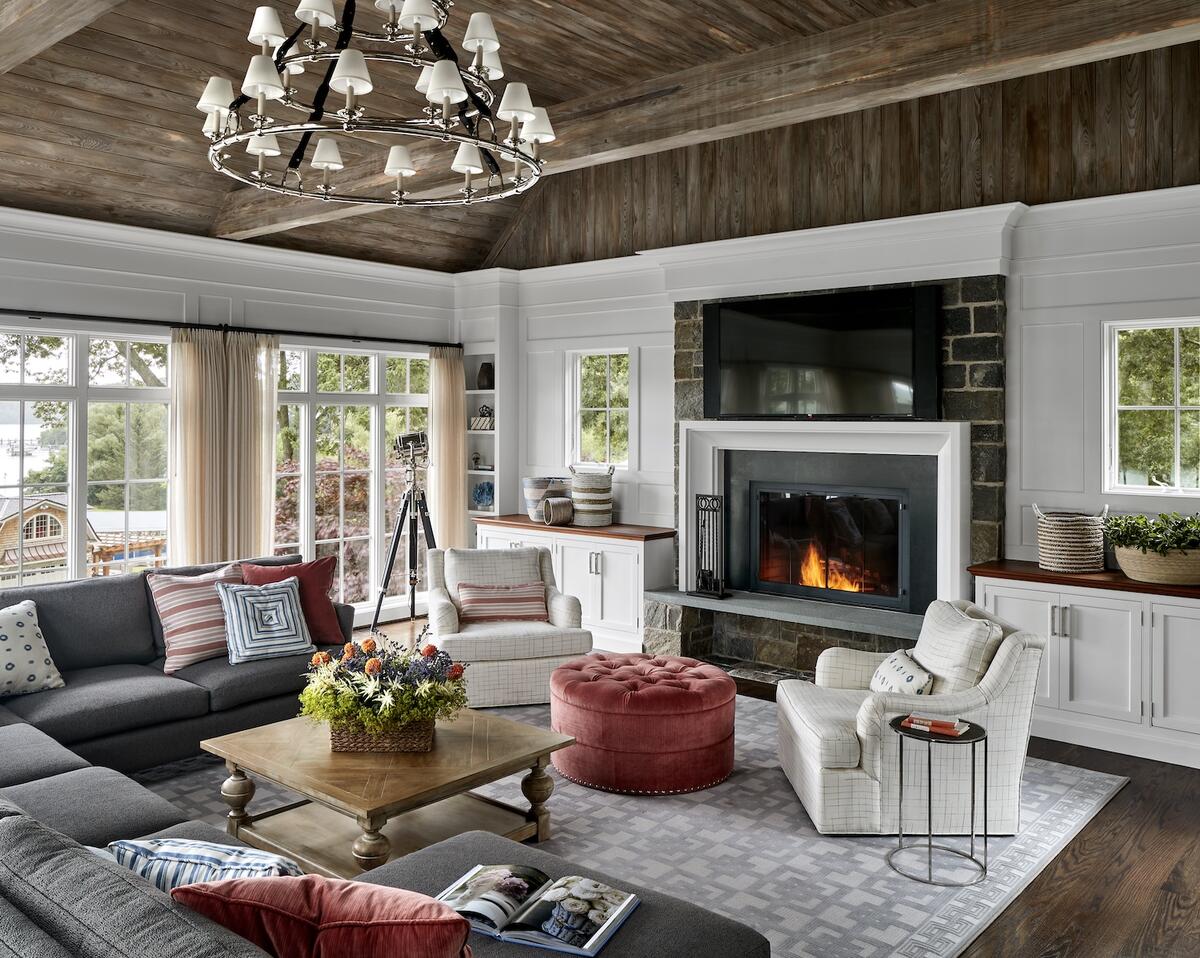
A rustic ceiling gives way to a refined living areaCourtesy of McCory Interiors
How did you get comfortable delegating?
It’s a hard thing. But I started thinking about it from a client’s perspective. I mean, we’re coming into their home as designers and spending a lot of money—they’re investing a lot of money into these projects—and it’s about building a relationship and trust with the person.
I’ve never thought of it that way, but I love that approach. We’ve talked before about how you built your team and systems after a personal crisis about whether to stay in design.
Yes—and I think the other driving factor is my daughter. I had her at a later age, so I’m a lot more tired than a young mom, and I’m running my own business. It got to the point where I would be out in meetings all day, come home, be a mom, and then she’d go to bed and I’d get on my computer and be up until 3 o’clock in the morning doing everything. I’d go to sleep for a couple hours, then wake up and do it all over again. It was nonstop, and I did that for years.
I just opened a little office space, which was the scariest thing, but it built an automatic boundary for my clients and it’s been the best. Come 4 or 5 o’clock, I’m done—I go home, I can unwind, I’m with the family, and the minute my daughter is in bed, I am too. I have a little bit more of a life, and I’m even back at the gym.
When you look ahead, where do you see opportunity to grow?
I want to have my own line. That’s always been a goal. Ever since I worked at Stark, I’ve always said I’m going to come up with my own patterns and designs for a wallpaper and fabric line. I’ve done it once, with a wallpaper patterns in a Junior League of High Point showhouse, but then I stopped there. That’s what I’m working on. By spring, I’m hoping to have a bunch of different options to push something into fall or the beginning of 2024.
Is that something you’ll do independently, or are you looking for a brand partner to bring that to market?
That’s a good question. I’m probably looking for a brand partner that can sell it for me.
Could you tell me a little bit about the design scene in Connecticut?
Connecticut’s a funny place. I’m in central Connecticut, on the border of Litchfield, which is very different than Greenwich and Fairfield. We’re central to Boston and to New York, which makes it easier to venture out to the other states. Locally, we have a lot of little antique shops, which are beautiful and great—Stanford is loaded with them. We also have Design Source, our design center in Hartford.
The market is interesting. There’s a lot of hidden money in the area. You have your mansions and your McMansions. There are a lot of historical areas that have beautiful houses. And there are a lot of bubbles, like West Hartford, where the houses might only be 1,500 square feet, but people are going all-out and wanting to decorate them to the nines—fancy murals and details, details, details. Sometimes those are the most fun.
So it’s not necessarily square footage that’s going to indicate investment or what the job is going to require?
Correct. I used to think more about the square footage of a house, but I’ve realized that it’s more about the character of the house. And I feel like the people here in central Connecticut use designers a lot more than they used to—maybe because there are a lot more of us working here now. It’s almost a must in their minds, where before it was a luxury. It still is a luxury, but with so much talk about it, people just automatically think, “That’s what you do: You hire a designer.”
So often design communities operate with a scarcity mindset. But what you’re saying is so refreshing—that having more designers in your area makes people more confident to invest.
It’s relatively new that it’s turned into more of a community. We all have different aesthetics, and we all understand that there’s enough design out there for everybody. I don’t feel like people are competing the way they used to. I think as more people know who they are as designers, the clients are finding who they should be working with.
When I started this series in 2020, I think it was way more shocking to hear someone say, “That’s not my client, and that’s OK.” In some ways, the widespread adoption of that mindset feels very new for our industry.
And it’s refreshing. It’s comforting. It took me a long time to accept that and say, “That’s not my client and there’s nothing wrong with that. I know who that client is for and I’m going to pass their name along to them.” I’ve had people pass clients to me that weren’t a fit for them, too.

McCory created a custom graphic wallpaper pattern to anchor a rich, tonal showhouse bedroomRead McKendree
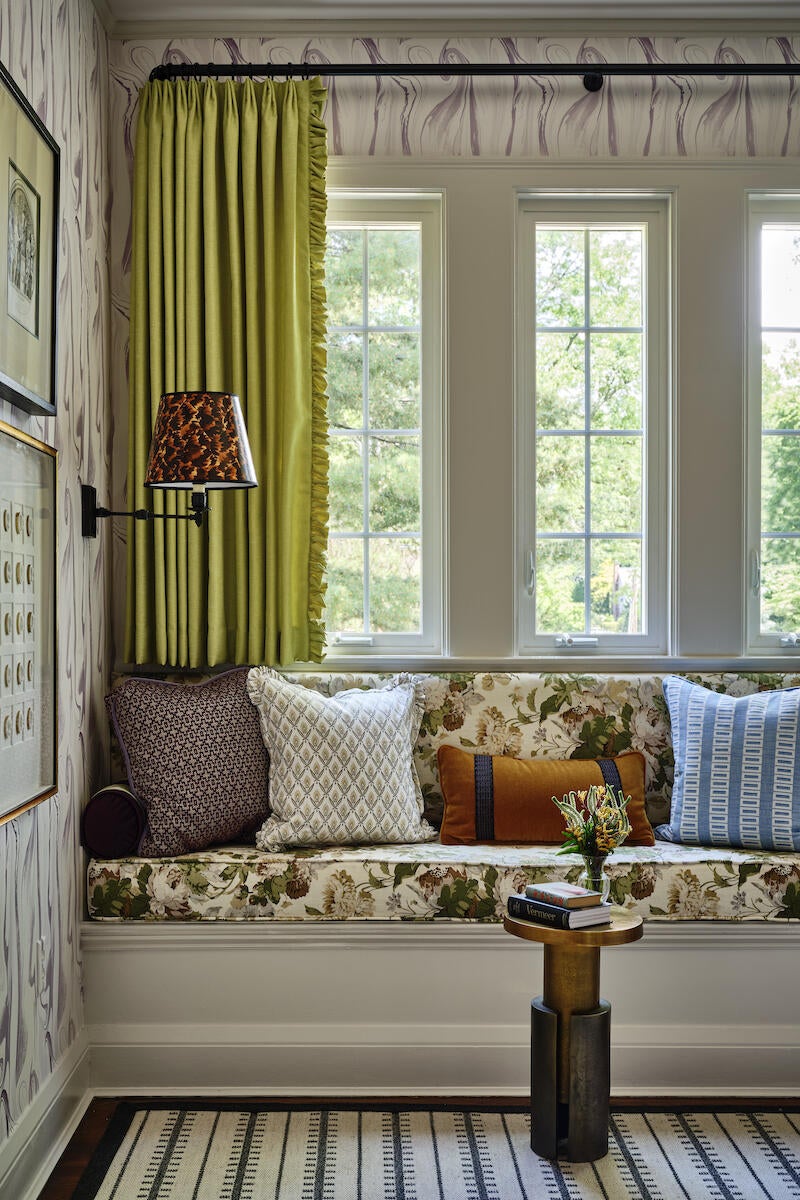
A cozy nook in the Junior League of Hartford showhouseRead McKendree
Left: McCory created a custom graphic wallpaper pattern to anchor a rich, tonal showhouse bedroom Read McKendree | Right: A cozy nook in the Junior League of Hartford showhouse Read McKendree
What does success look like to you?
Being happy with what I’m doing, for [the right] clientele. And having my own line—I’ve talked about it for so long, and I think not doing it would be one of my biggest regrets. I feel like I’ve just tapped in, and the future of Kristen McCory Interiors is 100 percent in my hands, and that it can go in great places if I continue down this road.
That’s amazing. What’s been the biggest secret to getting that right?
Hiring. I know a lot of designers that have employees who come and go. It’s funny because I made one hire immediately, but I’ve still taken the time to make sure the people I’m hiring not only make sense for the business, they’re also people that I respect and who have the same values.
How do you create that workplace culture?
It’s how I’ve curated my team. The employee who does procurement is an athlete at heart, and I have a special feeling for other athletes. There’s just something there that we all relate to when you’ve performed at that level. There’s a different mindset, and that was huge to me. And my most recent hire, too—I’ve actually known her for years, and she’s always loved design. She doesn’t have a huge background in it, but she loves antiques and has a great eye. I actually took her to High Point Market with me—because I knew she would enjoy it, but it was also a five-day interview, even if she didn’t realize it. She was very excited to go, and meanwhile I’m watching every move. By day three, I knew I wanted her by my side wherever I travel. She just got it.
Everyone on my team has worked in the professional world. They’re my age or a little older, so there’s a level of maturity. Everybody’s responsible, reasonable and communicates, which are the big things for me. They get their work done, they know when they have to go that extra mile—and when they do, they’re willing to do it and they’re more productive because they know that they have the time they need to do what they need to do outside of work. The stress isn’t there on a daily basis to perform, perform, perform. One might pick up the pieces for the other if something’s going on. We truly work together.
I would say I’m kind of lenient on everyone, but it’s because they’re all so responsible. If something comes up, it’s like, do what you have to do. They know what they’re responsible for—as long as they’re doing their part and communicating, then by all means take the day off, or go play tennis this morning. Because the other thing that I’ve learned is you have to take care of yourself. That is something that I’ve worked on in the last eight months, very specifically on myself.
What prompted that for you?
I lost myself. I realized that I didn’t know who I was as a person, and I didn’t know who I was as a designer. I had pretty much given up everything that kept me sane: going to the gym, playing sports, a social life. I just literally gave up everything—I was working around the clock and I didn’t have much of a life. I got to a point where it was like, “I can’t do this, I need friends.” Not to always bring it back to sports, but I was a Division 1 athlete on a team where everybody had a role, a position and a spot they filled. So that’s where my brain went, and that’s when I began to search for my team. And since I’ve done that, and focused on allowing myself to be myself, I guess you could say that I want to make sure that anyone who’s working for me can do that too.
Once I started delegating, I started taking care of myself again and enjoying life more. I hired one person, and then we brought in another eight months later, and then another 10 months later. And in that process, I was able to come back to my roots: Who am I as a designer? What do I like? How do I want to build relationships with my clients? I gained that perspective back as I started to see clearer again.
What was the work that you had to do to regain that clarity?
I think it was honoring myself outside of my career. I’m a very driven person—I’m sure most designers are. You set goals for yourself and you want to hit them. And when you have that drive, you’re sometimes willing to do whatever it takes to get there, even if it means staying up until 3 o’clock in the morning again and again. But what I realized is, no, that’s not how you do it. You take time with your family. You go to the gym and work out. You go out with friends. It’s important to honor yourself, because the more you take care of yourself, the better you’re going to perform.
Do you set goals differently now as a result?
I think so. Before, my goals were huge. They were long term. And right now, my goals are more short term: What’s happening next week? What are we crossing off the list? I still have long-term goals, but if you don’t fix or finish the things that are in front of you, those long-term goals are never going to happen. And I have to tell you, there’s instant gratification in saying, “This is what’s on our list. Let’s get A, B, C and D done.” We find ourselves having more time at the end of the week to work on those long-term goals, like the wallpaper. There’s nothing better than crossing things off the list.
To learn more about Kristen McCory, visit her website or find her on Instagram.

